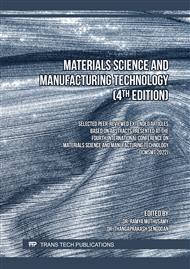[1]
M. H. Saad, B. M. Darras, and M. A. Nazzal, Evaluation of Welding Processes Based on Multi-dimensional Sustainability Assessment Model,, International Journal of Precision Engineering and Manufacturing-Green Technology, 2020/01/21 (2020).
DOI: 10.1007/s40684-019-00184-4
Google Scholar
[2]
M. A. Wahid, Z. A. Khan, and A. N. Siddiquee, Review on underwater friction stir welding: A variant of friction stir welding with great potential of improving joint properties,, Transactions of Nonferrous Metals Society of China, vol. 28, pp.193-219, 2018/02/01/ (2018).
DOI: 10.1016/s1003-6326(18)64653-9
Google Scholar
[3]
M. A. Wahid, Z. A. Khan, A. N. Siddiquee, R. Shandley, and N. Sharma, Analysis of process parameters effects on underwater friction stir welding of aluminum alloy 6082-T6,, Proceedings of the Institution of Mechanical Engineers, Part B: Journal of Engineering Manufacture, vol. 233, pp.1700-1710, 2019/05/01 (2018).
DOI: 10.1177/0954405418789982
Google Scholar
[4]
B. Darras and E. Kishta, Submerged friction stir processing of AZ31 Magnesium alloy,, Materials & Design, vol. 47, pp.133-137, 2013/05/01/ (2013).
DOI: 10.1016/j.matdes.2012.12.026
Google Scholar
[5]
O. Jarrah, Investigation of Friction Stir Back Extrusion,, Thesis, M.S.c, Mechanical Engineering, American University of Sharjah, (2019).
Google Scholar
[6]
J. L. a. F. Abu-Farha, On The Manufacture Of Lightweight Alloy tubes Via Friction Stir Back Extrusion , ASME 2014 International Manufacturing Science and Engineering Conference vol. MSEC2014-4148, (2014).
DOI: 10.1115/msec2012-7358
Google Scholar
[7]
M. Nazzal, F. Abu-Farha, and R. Curtis, Finite Element Simulations for Investigating the Effects of Specimen Geometry in Superplastic Tensile Tests,, Journal of Materials Engineering and Performance, vol. 20, pp.865-876, (2011).
DOI: 10.1007/s11665-010-9727-9
Google Scholar
[8]
M. A. Nazzal, Stability analysis and finite element simulations of superplastic forming in the presence of hydrostatic pressure,, AIP Conference Proceedings, vol. 1957, p.050006, 2018/04/19 (2018).
DOI: 10.1063/1.5034336
Google Scholar
[9]
M. A. Nazzal and A. G. Al Sabouni, The effects of pressure control technique on hot gas blow forming of Mg AZ31 sheets,, International Journal of Material Forming, vol. 12, pp.519-533, (2019).
DOI: 10.1007/s12289-018-1432-5
Google Scholar
[10]
M. A. Nazzal and M. K. Khraisheh, The Effects of Stress State and Cavitation on Deformation Stability During Superplastic Forming,, Journal of Materials Engineering and Performance, vol. 16, pp.200-207, (2007).
DOI: 10.1007/s11665-007-9032-4
Google Scholar
[11]
M. A. Nazzal and M. K. Khraisheh, Impact of Selective Grain Refinement on Superplastic Deformation: Finite Element Analysis,, Journal of Materials Engineering and Performance, vol. 17, pp.163-167, 2008/04/01 (2008).
DOI: 10.1007/s11665-007-9180-6
Google Scholar
[12]
M. Nazzal and M. K. Khraisheh, Finite Element Modeling of Superplastic Forming in the Presence of Back Pressure,, Materials Science Forum, vol. 551-552, pp.257-262, (2007).
DOI: 10.4028/www.scientific.net/msf.551-552.257
Google Scholar
[13]
A. K. S. Alan A. Luo, Mechanical Properties and Microstructure of AZ31 Magnesium Alloy Tubes,, in Essential Readings in Magnesium Technology, A. A. L. Suveen N. Mathaudhu, Neale R. Neelameggham, Eric A. Nyberg, Wim H. Sillekens, Ed., ed, 2014, pp.381-387.
DOI: 10.1002/9781118859803.ch61
Google Scholar
[14]
D. Hasenpouth, Tensile High Strain Rate Behavior of AZ31B Magnesium Alloy Sheet,, ed: UWSpace, (2010).
Google Scholar
[15]
M. K. Kulekci, Magnesium and its alloys applications in automotive industry,, The International Journal of Advanced Manufacturing Technology, vol. 39, pp.851-865, 2008/11/01 (2008).
DOI: 10.1007/s00170-007-1279-2
Google Scholar
[16]
Z. Zeng, N. Stanford, C. H. J. Davies, J.-F. Nie, and N. Birbilis, Magnesium extrusion alloys: a review of developments and prospects,, International Materials Reviews, vol. 64, pp.27-62, 2019/01/02 (2019).
DOI: 10.1080/09506608.2017.1421439
Google Scholar
[17]
M. Ahmadkhanbeigi, O. Shapourgan, and G. Faraji, Microstructure and Mechanical Properties of Al Tube Processed by Friction Stir Tube Back Extrusion (FSTBE),, Transactions of the Indian Institute of Metals, vol. 70, pp.1849-1856, 2017/09/01 (2017).
DOI: 10.1007/s12666-016-0987-4
Google Scholar
[18]
M. H. Saad, M. A. Nazzal, and B. M. Darras, A general framework for sustainability assessment of manufacturing processes,, Ecological Indicators, vol. 97, pp.211-224, (2019).
DOI: 10.1016/j.ecolind.2018.09.062
Google Scholar
[19]
M. H. Saad, O. M. Jarrah, M. A. Nazzal, B. M. Darras, and H. A. Kishawy, Sustainability-based evaluation of Friction Stir Back Extrusion of seamless tubular shapes,, Journal of Cleaner Production, p.121972, 2020/05/10/ (2020).
DOI: 10.1016/j.jclepro.2020.121972
Google Scholar
[20]
F. Abu-Farha, A preliminary study on the feasibility of friction stir back extrusion,, Scripta Materialia, vol. 66, pp.615-618, 2012/05/01/ (2012).
DOI: 10.1016/j.scriptamat.2012.01.059
Google Scholar
[21]
J. L. Milner and F. Abu-Farha, On the Manufacture of Lightweight Alloy Tubes via Friction Stir Back Extrusion: Process Evaluation and Material Performance,, p. V002T02A085, (2014).
DOI: 10.1115/msec2014-4148
Google Scholar
[22]
-. G. Jamali, -. S. Nourouzi, and -. R. Jamaati, - Microstructure and mechanical properties of AA6063 aluminum alloy wire fabricated by friction stir back extrusion (FSBE) process,, - Int. J. Miner. Metall. Mater., vol. - 26, pp. - 1005, - 2019-08-05 (2019).
DOI: 10.1007/s12613-019-1806-9
Google Scholar
[23]
O. M. Jarrah, M. A. Nazzal, and B. M. Darras, Numerical modeling and experiments of Friction Stir Back Extrusion of seamless tubes,, CIRP Journal of Manufacturing Science and Technology, vol. 31, pp.165-177, 2020/11/01/ (2020).
DOI: 10.1016/j.cirpj.2020.11.001
Google Scholar
[24]
A. Alhourani, M. Awad, M. A. Nazzal, and B. M. Darras, Optimization of friction stir back extrusion mechanical properties and productivity of magnesium AZ31-B seamless tubes,, Proceedings of the Institution of Mechanical Engineers, Part B: Journal of Engineering Manufacture, vol. 235, pp.2143-2154, 2021/11/01 (2021).
DOI: 10.1177/09544054211014465
Google Scholar



